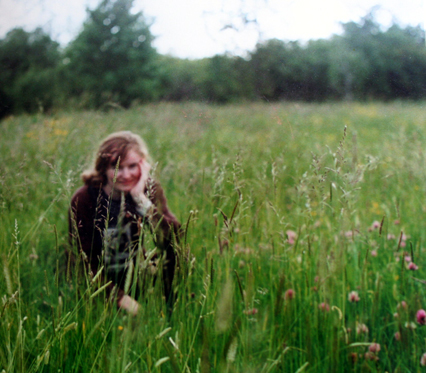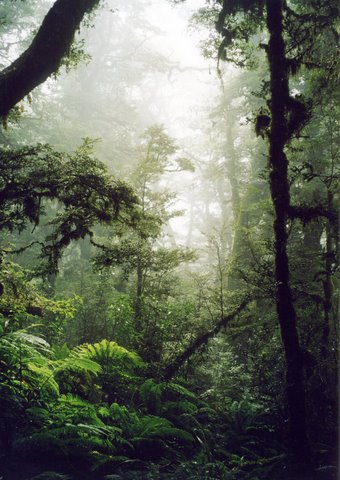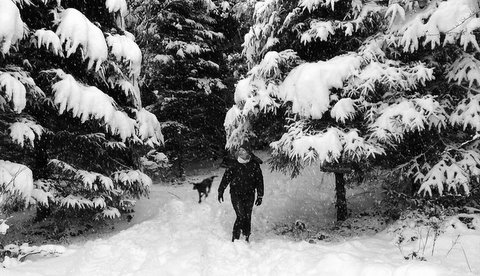Cathy Fitzgerald is a rural-based experimental filmmaker / visual artist with a background in research biology. Born in New Zealand she has lived in Ireland for 15 years. She is presently a Visual Culture PhD Scholar at the National College of Art & Design (NCAD), Dublin, Ireland. She is looking at experimental film (practice and theory) and ecology in this age of biospheric crisis. Her writing and films on ‘The ecocidal eye: towards a relational gaze in cinema’ can be seen at: www.ecoartflm.com
‘I thought again of our fundamental inversion of all relatedness, of how we nearly always ask the wrong question –What can I get from this?–and so rarely the right one–What can I give back? Even when we try to learn from others, it is from the same spirit of acquisition: What can I learn from this forest ecosystem that will teach me how to manage if for maximum resource extraction? Rarely: What can I learn from this forest community that will teach me better how to serve it?‘
Derrick Jensen, A Language Older than Words, 2000, p. 319
Last December on the 30th celebration of the Irish Green Party and in the last few weeks of the UN International Year of the Forest, I presented on behalf of the forestry policy group, a comprehensive new sustainable forestry policy for Ireland. It was accepted that day!!! The policy development had taken several years with the input and hard work of a small number of committed members. It had involved wide consultation with forest and other environment/ natural heritage groups, professional foresters and policy makers from here and overseas.
My own personal involvement in policy development was propelled for a number of reasons: over several years my partner and I, with the help of a local sustainable forester, have been transforming our very small 25 year old conifer plantation into a permanent (non clear-fell) forest using Close-to-Nature continuous cover sustainable forestry methods. This is because I have a strong belief that we need to create radical new ways of relating to our natural environments, if we and those environments that support us all are to thrive in the long-term. I have spent considerable time too on a long term art & ecology project of which my forest is central to my work.
I also wanted to help introduce policy that would finally address the appalling irresponsibility of current Irish policy that ignores the devastation that we inflict on other human and natural communities when we continue to allow the importation of timbers and wood products from countries where unsustainable logging, often still from old growth forests, are occurring. As hidden behind the everyday headlines of economic collapse we are now living in an unprecedented age referred to as the age of the 6th great extinction. This Anthropocene age is where our own species actions alone are dramatically altering the very fabric of our finite biosphere. Around the world, the degradation of natural environments, the way we interact with our supporting land bases, has and continues to lead to unprecedented species, habitat and much cultural loss. This age of extinction, where we are losing 200 species every day, mirrors the ecocidal growth-at-all-costs politics of our hyper-consumerist industrialised societies, the now globalised dominant cultural model that fails, in a mixture of blind ignorance and short-term profiteering, to understand the limitations and sensitivity of environments that supports all life. For example, short-term returns obscure the fact that clear-fell forestry that relies on serial plantings of monocrops, will lead, in 4 or 5 rotations, to severe soil degradation and ever reducing timber volumes. Such practices also limit and disrupt other species and dull the social and cultural values of our forests in the meantime.
On a global scale, we know our forested areas are critical in regulating our climate and storing carbon and are the most important habitat for most terrestrial species, but do we relate that every effort should be to grow more now, to sustain and create more resilient and diverse (uneven aged and mixed species) permanent forests? Diverse forests, for instance, will be crucial to counter the effects of changing climate with its increased likelihood of tree disease. On a national scale and when other fuel costs are set to keep rising, local fuel independence provided by well managed, selectively harvested permanent forests must be part of the equation to support local economies and communities fuel requirements not to mention improving local biodiversity. I now also understand why leading sustainable European foresters see such potential in transforming much of Ireland’s pioneer conifer plantations to permanent forests. I’ve long known we have the best tree growing conditions in Europe but I can now see that we have too long focussed solely on short-term economic returns of forest plantations forgetting the intrinsic ecological and cultural wealth that our ancient biodiverse Irish Forests once provided. In some small measure I hope ideas in the new Irish Green Party forestry policy will help enable a new expanded vision of permanent forests potential to circulate more widely in Ireland and elsewhere.
I am very fortunate that my thinking and practical knowledge about forests has come from both long associations with leading people from Crann (an Irish forest group), ProSilva Ireland and ProSilva Europe (sustainable forestry organisations) and from living within a small forest. In recent years on study tours I have experienced the vibrant mixed species, permanent forests in Hungary, Slovenia, Austria and the Netherlands that are managed carefully for ecological, cultural, as well as economic benefits. Fifteen years ago, when I first came to Ireland from New Zealand, I worked on a Crann Leitrim project and witnessed the largest Forest Service supported county-wide planting of broadleaf woodlands amongst local farmers and those interested in doing something different with their land. My friendships with leading forest practitioners from then continues to this day and some years ago I had the good fortune to go back to Leitrim to make a small film of the ‘local project’ as it had been called, where I interviewed the new woodland owners and the vibrant mixed woodlands that I had seen planted not many years before. Such projects were so important in practically illustrating the need for new policy then. We have come a long way in that broadleaf tree planting and increased afforestation are now well supported but we still have so much to learn that planting any species as crops is shortsighted and will never lead to longterm wealth or real forests.
On the practical side, my own observations of the small forest in which we live has been invaluable. Our tiny, 21/2 acre forest-in-the-making, comprising of 25 year old conifers undergoing periodic selective harvesting, now supplies us with over 70 tonnes of firewood every three years! We have had to start selling firewood to our neighbours to cope with our clever, fast growing forest. And as the integrity of our small forest remains intact, since we do not clear-fell, we have more and different birds every year and incredible range of fungi too. More valuable ash and some oak trees are self generating and growing quickly in the shelter of our large conifers (they’ll grow quicker and straighter in such company without us having to waste energy to prune them too). So from my window I can see our small acreage is a more vibrant community where the real wealth is embedded and accumulating in the diversifying, aging forest! Such forestry does require a long-term, slower mindset. Its one that attempts to respect all aspects of what makes a forest (which is very complex and dynamic when you think of it) and with it, thinking of new ways of relating to its living inhabitants so all thrive and survive. Its a type of slow-forest, interdependent management where one seeks to carefully observe and understand rather than quickly exploit and move on. So thinking and working in forests has for me been an important means to think about some very real aspects of deep sustainability in the wider context too. Where deep sustainability refers not only implementing measures for our own benefit but measures that ensure all aspects of a forest thrive. By the way, our small 2 1/2 acre site is now listed with a growing number of other sites around the country on the new Coford research database of forests undergoing transformation, or as they refer to it, being managed by implementing low impact silvaculture systems (LISS).
From a completely different view, as an artist I have long been fascinated and in turn equally concerned by what has created contemporary culture’s short-sighted ecocidal perspective. I have been influenced and inspired by artists and writers before me. However I am often shocked and at a loss how too few artists today examine our relation to the living world in any depth. Perhaps my previous working background in the biological sciences means I have always been drawn to and feel more able to engage with ideas and concerns about our increasingly growing ecological crises. I have of course always been drawn to artists that have related to forests too.
I suspect that many members of the Green Party and the public in general would be unaware that some of the early formative material for the first Green Party in Germany evolved from ideas from the leading 20th century German artist, Joseph Beuys. Beuys was a founding member of the first Green party and later unsuccessfully stood as a Green Party candidate for the European Parliament. A highly charismatic, self-professed shaman-like figure, Beuys was an outspoken artist attracting considerable media attention for his ideas about the central and essential role of art in society. He considered all members of society active agents in shaping society (he’s widely known for his claim that ‘everyone is an artist‘ and also that truly healthy societies support and understand that ‘art = capital’). Beuys also had a deep understanding that a healthy environment is a necessity for healthy societies. As an arts professor he had controversial ideas that the arts must be freely available to all, opening his classes to un-enrolled students. Although very popular with students and other artists such controversial ideas eventually lead to his dismissal as Professor from the Dusseldorf Arts Academy. Though his political ideas about society, education and the environment were instrumental to the newly forming Green Party, his involvement in politics was not to last either, as he was frustrated by the slow democratic process of the new party and in hindsight, his own eccentric character seemed ill suited to connect with the general public. Even so, he carved a considerable public profile for his works and ideas, and to this day he is highly regarded in bringing art out of institutions and galleries to create projects that combined community actions, what he termed ‘social sculpture’, to address eco-societal concerns in the wider public domain
While it is difficult to condense Beuys’ work into a short article, his final large scale project, 7000 oaks for the International Documenta Arts Exhibition in Kassel (1982) city left a lasting legacy for the German city and contemporary art. Creating a huge mound of 4 ft high basalt stone pillars outside the entrance of Documenta, he stipulated that each of the 7000 stone pillars could only be moved to be placed alongside a planted oak, both of which were to be put in the environs of Kassel city. After considerable city-wide debate, communities and individuals working with local government and other community institutions carried out his forced urban tree planting project over 5 years. Though initially greeted with much skepticism this new type of community art project eventually gathered wide and popular support and has been replicated in other cities. Beuys instinctive understanding of relational community art practice has also been immensely important to contemporary art.
Beuys’ idea of the oak each being planted along with a stone pillar also presented an intriguing means to project this artistic endeavour well into the future; the pillars act as permanent markers of the townspeople actions to future generations, reminding them of the long-term thinking and environmental actions of its previous citizens. Such deeply symbolic practical actions encompassing long-term thinking for society is much needed now but not only in our cities. In fact Beuys sought to have this project replicated all over the world. An important legacy of Beuys work continues now through the Social Sculpture Unit in Oxford and last year when I visited I heard that over 80 art and forest projects from around the world were connecting with their University of Trees network project. Of course, when you think of it, we have our own standing stone reminders in Ireland. Our ancient Ogham alphabet carved on our standing stones all tellingly describe our then high regard for our native forest species, each letter corresponding to a native tree or shrub. It might be that Beuys had remembered this as he a deep interest in celtic Ireland too.
Postscript: when I started writing this article a week ago I received a short Skype message from a leading sustainable close-to-nature forester in Tasmania. He had discovered and enjoyed looking at my short, birdsong narrated film I had created about our forest practices, called Transformation but noticed an error under a photograph I took of fabulous permanent forests in Slovenia where I had noted that clearfelling in Slovenia has been illegal these past 25 years. He wrote, ‘Just noticed the comment under the photo from Slovenia. Clearfelling in Slovenia was ended in 1948! That is 64 years of changed thinking and planning and operating”
… I hope we too reach such longterm forestry practice in the very near future both here and Ireland and beyond.
Further Reading
Strangely like war: the global assault on forests by Derrick Jensen and George Draffan (2005), see also A language Older than Words, Derrick Jensen (2000)
Forests: the shadow of civilisation by Robert Pogue Harrison, 1992.
Beuysian Legacies in Ireland and Beyond: Art, Culture and Politics by Christa-Maria Lerm Hayes and Victoria Walters, European Studies in Culture and Policy, Lit Verlag, 2011






























Interesting and detailed article. I think there should be more art that creates lasting landscape artifacts to connect future communities with their surroundings in a positive way and more thought-provoking tree planting with a lasting legacy.
Hi Lara,
glad you like it! Delighted to share these ideas and our new Irish forest policy ideas too.
I have just reread this thoughtful and informative article again Cathy, many thanks for letting me know about it and for your generous reference. It is wonderful to get a sense of how you came to be involved and engaged, and to have such an impact in this area. One of the most rewarding things I have done this year is to talk to some of the undergraduates at WSA about the “7,000 Oaks” project quite informally, rather than in a lecture context, and to hear their thoughts and responses, which were both generous and wise. And so the momentum, one hopes, passes along xx
Hi Victoria,
Thanks for the wonderful comment – it came when I was away on holiday so only replying now.
The Hollywood project continues, as do Beuys’s ideas, and we now has a steady trickle of visitors too. I hope to publish an audio visual ebook in the next year too, so will let you know about it and for others interested there will be details will be on my website http://www.ecoartfilm.com